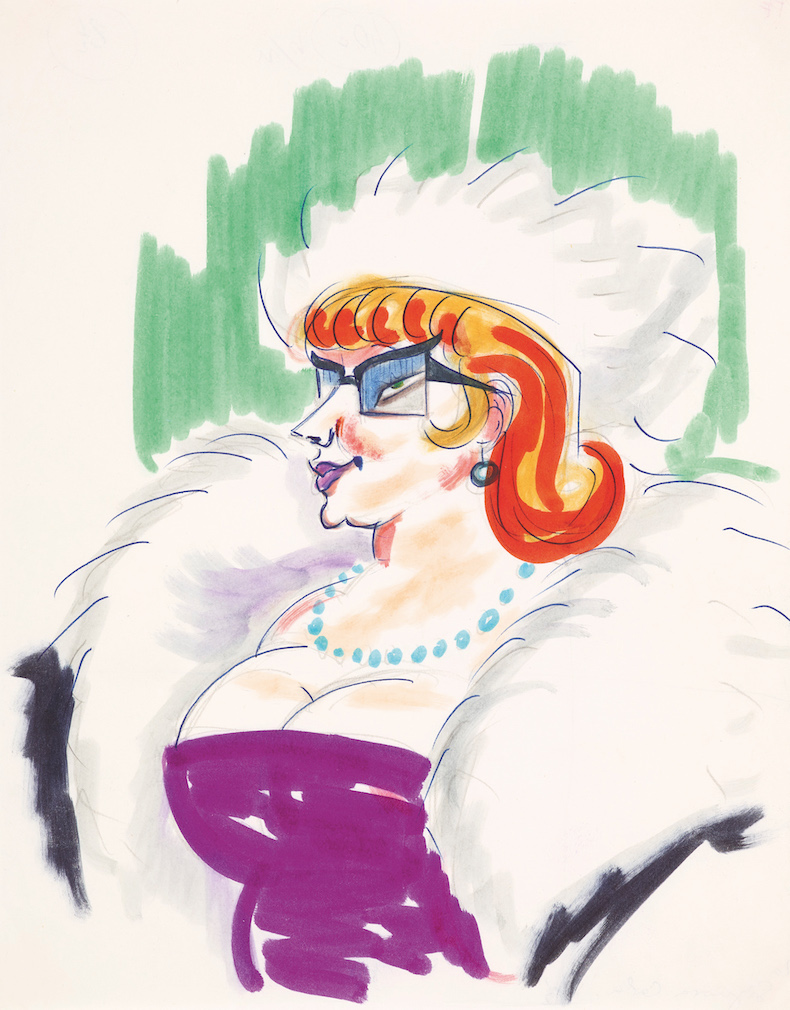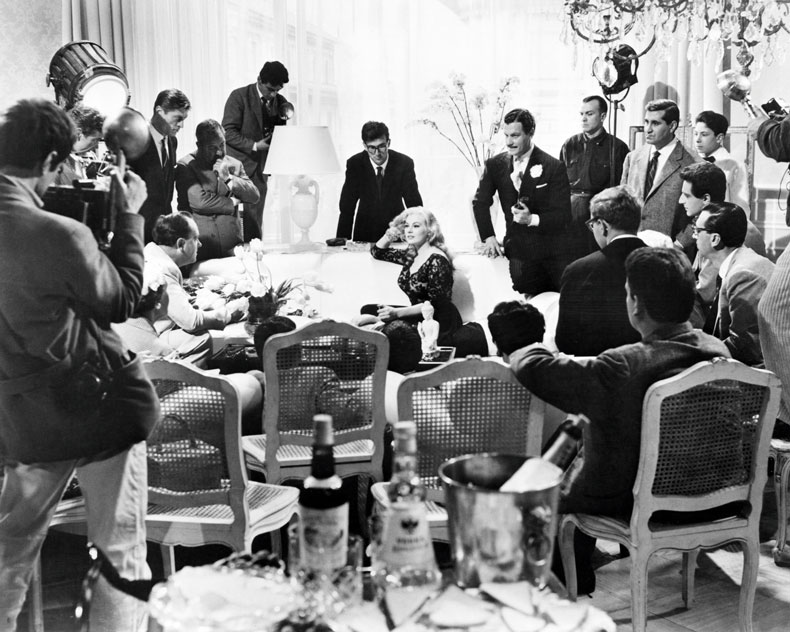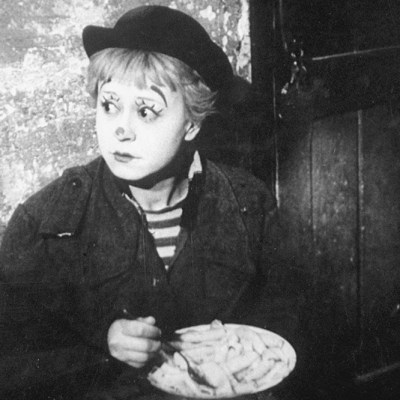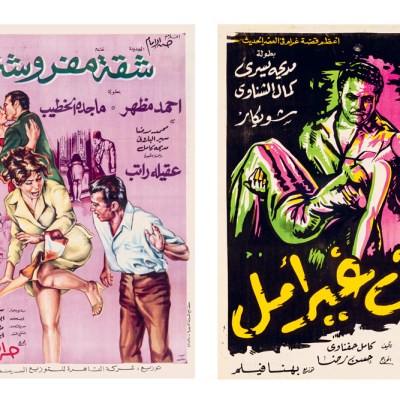From the July/August 2025 issue of Apollo. Preview and subscribe here.
If aliens unfamiliar with the concept of a film industry were to land in Rome, see the Colosseum, the forums, the Arch of Titus and other ancient monuments, one wonders what they would make of the fact that only a short distance from the city’s centre, humans had for decades been busily recreating these very same buildings in plaster and fibreglass, often only to dismantle them as soon as they were finished. What they would soon discover, of course, is that this continuous construction site, which calls itself Cinecittà, was devised as a 20th-century equivalent of the Colosseum: a vehicle for thrills and spills on a spectacular scale, but with the entertainment in question more likely to involve food colouring than real blood. Here is modern man’s bread and circuses.
For Federico Fellini – the director most closely associated with Cinecittà – these flimsy imitations were more expressive of the originals than the originals themselves. This sense of a superior (un)reality started when he was making La Dolce Vita (1960). Frustrated by the challenges and pressures of shooting on the Via Veneto in central Rome, Fellini had set designer Piero Gherardi reconstruct the famous street at Cinecittà – exact down to the last detail, claimed the director, except one: it was built on the flat, instead of sloping as it is in reality. ‘When I go past the Café de Paris,’ the director wrote 30 years later, ‘I cannot stop myself thinking that the authentic Via Veneto was the one in Studio 5, and that the dimensions of the street in the studio were more accurate or certainly more attractive.’
Fellini took this approach to the extreme in his penultimate work Intervista (1987). In the film, which is more explicitly autobiographical than 8½ (1963), Fellini plays himself, as the subject of a (fictional) documentary being made by a Japanese production company. Much of the action, inevitably, is set in Cinecittà. Yet he still felt the need to recreate the place within the place. ‘The Cinecittà which appears to be seen from the air at the beginning of the film was a mock-up,’ the director explained in 1988. ‘I could have done aerial shots from a helicopter, but the result would have looked more like a map of the place, which because it is real does not mean anything, does not communicate any particular feeling. No, I wanted to do Cinecittà differently: using the model, I was able to re-route the avenues of pine trees, give the tarred roofs a different colour, and by making the buildings all grey, give them a kind of official format without any real sculptural quality.’
Federico Fellini on the set of Casanova at Cinecittà in July 1975. For other scenes the studios’ pool was used to suggest the Venetian lagoon and canals. Photo: Santi Visalli/Getty Images

In one of the film’s flashbacks, the aspiring young journalist Fellini takes a tram crowded with actors and wannabes from central Rome along Via Tuscolana (the Viale della Speranza of Dino Risi’s 1953 title) to Cinecittà. He’s there, for the very first time, to interview a well-known diva. It’s the late 1930s, and Europe’s largest film studios is only a couple of years old. On 28 April 1937, Benito Mussolini had inaugurated Italy’s state-of-the-art movie-making complex built on 144 acres of land 10km south-east of the capital.
Fellini later recalled seeing a newsreel of the event at the time, in which ‘Il Duce’ stops for a few words with ‘men and women wrapped in what looked like sheets that were in fact togas from a historical film, and exchanging both an ancient and Fascist Roman salute with them’. Among the various newsreels produced by the state-controlled film agency Istituto Luce (whose archives are now managed by Cinecittà), a clip of toga-clad extras at the inauguration is not, for this researcher at least, in evidence. Yet Fellini – never one to distinguish between fact and fiction anyway – has in his reconstructed memory of the footage imbued it with a truth, which is Mussolini’s obsession with ancient Rome. That same year, his regime was commemorating two millennia since the birth of Augustus, a ruler expert in deploying the power of image-making and with whom the Fascist leader was keen to be associated. In the capital itself, an exhibition on the history of Rome and the concept of romanità was mounted, while Augustan buildings such as the emperor’s forum and his mausoleum were being rehabilitated; at Cinecittà, such edifices were evoked in wood and papier mâché, gleaming as new.
Even before the studios’ official opening, shooting had finished for Scipio l’Africano, directed by Carmine Gallone. Naturally, a film about the Roman general who defeated Hannibal at Carthage was in large part a propaganda exercise for an Italian dictator who had invaded Ethiopia in 1935. His cinephile son, Vittorio Mussolini, was producer, and the poster features a figure who, with his round helmet, thick neck and cleft chin, resembles not so much a Roman legionary as a Fascist strongman. The film was an impressive spectacle – with thousands of extras, dozens of live elephants and colossal scenography – and anticipated the run of high-budget historical epics that would be made at Cinecittà in the 1950s and beyond: Quo Vadis, Ben-Hur, Cleopatra.
An artist at work in the prop department at Cinecittà, 1956. Photo: Bettmann via Getty Images

Toga-clad or not, the serried ranks of people lining Mussolini’s route at the inauguration in 1937 – many of them bearing military standards – resembled so many extras in a classical film. In one photograph from the event, a vast cut-out of Il Duce looking through the viewfinder of a tripod-mounted movie camera has been set up on an artificial clifftop, along the ridge of which, spelt out in white capital letters, are the words: La cinematografia è l’arma più forte (‘cinematography is the strongest weapon’). Could this have been Fascism’s verbose, somewhat less jaunty response to the Hollywood sign?
Italians’ appetite for cinema, up to that point, had been mostly fed by America. And Hollywood had been making films set in Italy since the early 1920s, its stars acting like diplomatic envoys – witness Mary Pickford and Douglas Fairbanks being received by Mussolini at Palazzo Chigi in 1926, with the two parties expressing mutual admiration (Italy and the United States had recently agreed to reduce the former’s debt after the First World War). On a visit to Venice in 1931, Charlie Chaplin was paraded through the city on the shoulders of massed fans, and from his palazzo balcony was greeted by crowds fit for a doge. Meanwhile, embryonic neo-realists Luchino Visconti, Michelangelo Antonioni and Roberto Rossellini were cutting their teeth (as well as, perhaps, gritting them) on home-grown productions overseen by Vittorio Mussolini, or writing for his magazine, Cinema.
The idea for a national film-studio complex that could accommodate both the ambitions of the regime and those of the industry more generally was already being nurtured in the mid 1920s by Luigi Freddi, at the time a correspondent in the United States for the Popolo d’Italia. He had spent time in Hollywood, and in 1934 Mussolini appointed him General Director for Cinematography. When, the following year, a fire broke out at Cines Studios in south-east Rome, Freddi’s plans gathered pace. Gino Peressutti, a Friulian architect, was commissioned for the Cinecittà project. In preparation he visited soundstages in Germany, France and England – where he particularly admired Alexander Korda’s Denham Film Studios, which had been newly built to a design by Walter Gropius and Maxwell Fry. Unlike their outdated European counterparts, Peressutti recorded, these presented ‘an organic complex and a well-studied general layout, where the difficulty of filming outdoors, given the local climate, has evidently been taken into account’. However, he continued, ‘these establishments, however interesting, cannot be taken as a model for our country, where instead value must be given to the possibility of filming outdoors for a large part of the year.’ Thanks to Freddi’s field trips to Los Angeles, the architect could also study the blueprints of the Hollywood studios.
The entrance to the studios on Via Tuscolana, south-east of Rome. The complex was designed by Gino Peressutti and completed in 1937. Photo: © Andrea Martella; courtesy Cinecittà

Mussolini laid the foundation stone of the construction site in January 1936 and 475 days later he was giving his benediction to the end result: a group of 73 sleek, Rationalist-style buildings – Fellini and others would affectionately compare Cinecittà to a hospital or grand nursing home – with 16 soundstages, two pools for shooting maritime scenes and all the necessary facilities for post-production and set design, as well as a bar and restaurants. Over the next six years, until the bombing of Rome in 1943 and the end of Mussolini’s Ventennio, 279 films were produced there. The regime’s economic and censorial hostility to foreign films had turbo-charged home production (Hollywood, for its part, was embarrassed by a visit from Vittorio Mussolini in 1937 with a view to founding a co-production company with studio boss Hal Roach – by that point, Italy had agreed a formal coalition with Nazi Germany); though Italian films, too, were subject to strict censorship.
Cinecittà Babilonia (dir. Marco Spagnoli), a documentary produced in 2016 by Istituto Luce Cinecittà, draws on the institute’s extensive archives to expose the decadence behind the industry’s carefully controlled image. While the film’s subtitle, Sex, Drugs and Black Shirts, promises more than it delivers, the story of Luisa Ferida and Osvaldo Valenti, the hard-living, superstar movie couple of the era who were summarily shot by partisans in 1945, is a striking one. And in reality it was Valenti whom Fellini was going to interview on that first visit to Cinecittà in the late 1930s (or so he claimed). Having moved swiftly from journalism to screenwriting, Fellini is present during this Fascist period of Italian film, and not always on the periphery. In 1942 he co-wrote a screenplay with Vittorio Mussolini for the never-completed title Knights of the Desert, starring Valenti and Ferida; he may even have directed some of its scenes, which were shot in Libya. When Tripoli fell to the British during filming, he and his colleagues fled to Sicily on a German troop plane.
After the collapse of the Fascist regime in July 1943, Cinecittà’s 1,200 or so employees were dismissed. The studios were partly damaged in Allied bombardments the following year, and for several months occupied by German troops. In 1944 the Allied Commission turned Cinecittà into a refugee camp – Teatro 5, the soundstage that would become so dear to Fellini, is thought to have housed as many as 1,500 people in hundreds of cubicles, makeshift structures fashioned from the remnants of movie sets. While film-making gradually returned to the complex, it was only in 1950 that the last sections of the camp were dismantled; it’s conceivable, then, that some of those remaining refugees may have been among the 14,000 extras that took part in MGM’s Quo Vadis, the Technicolor epic that heralded the era at Cinecittà known as ‘Hollywood on the Tiber’.
An advert for Cinecittà placed in Cinema, a magazine edited by Benito Mussolini’s son Vittorio, in October 1940. Photo: ARCHIVIO GBB/Alamy Stock Photo

The Americans had finally arrived, lured by lower production costs and tax breaks, and the immense skill of Cinecittà’s crews and artisans. Those skills (to say nothing of patience) would be tested to the extreme with Cleopatra, the famously over-budget behemoth of a film whose production was transferred from the UK to Rome in 1961 – partly to persuade its star, Elizabeth Taylor, to show up on set more frequently. At Cinecittà, where the movie’s interiors and Roman exteriors were shot, production designer John DeCuir’s vast Roman Forum – which was larger even than the original a few miles away – exacerbated a country-wide shortage of steel tubing. Diva-like behaviour from the cast apparently extended to the elephants used for Cleopatra’s procession into Rome, one of whom rampaged through the studios’ soundstages.
Fellini, of course, had already satirised the Hollywood effect in Rome in La Dolce Vita. His recreation of the celebrity hotspot Via Veneto, with its attendant Paparazzo and friends, seems to have represented a watershed for the director. ‘From that moment on,’ he wrote in 1988, ‘for me Cinecittà has become a substitute for the world.’ He would later have a permanent office installed above his favourite soundstage, Teatro 5, with a dining room and kitchen attached. His tailor would come from Rome to give him fittings there. For Fellini, a lover of the circus, here was an ever-changing troupe to laugh at and applaud. He fondly compared the bar at Cinecittà ‘to an old lunatic asylum, where mental illness is in the company of its own illusions. And in fact you can see cardinals, revolutionaries, SS men, troglodytes, green lizards more than six feet long, and concubines, all drinking cups of coffee and eating slices of pizza […] [the bar] would not have looked out of place in a nightmare painting by Hieronymous Bosch.’
A permanent set of ancient Rome at Cinecittà, replicating the original Roman Forum. Photo: © Andrea Martella; courtesy Cinecittà

Having weathered, over the decades, the vagaries of the global film market, the rise of television, and several fires, Cinecittà today seems in reasonably good shape. Renovations, technological updates and expansions have been progressing over the last few years, thanks to £260m from the EU’s pandemic recovery fund. Teatro 18 now houses one of the world’s largest LED stages, and Mel Gibson’s sequel to The Passion of the Christ will make use of a brand-new studio complex – including a 3,500 sqm soundstage – when it shoots this summer. Meanwhile, the Italian government’s 40 per cent tax rebate for international film and TV productions continues the strategy first employed in the 1950s.
Since 2011 Cinecittà has been open for public tours, which lead visitors around permanent sets such as those of the HBO series Rome (2005–07) and Martin Scorsese’s Gangs of New York (2002). If they’re lucky, they might be shown the Cinears sculpture workshops, which have been run since 1937 by one dynasty of prop designers, the De Angelis family. How long their skills will be required in the digital age, time will tell. Yet it was precisely the material artifice of cinema that enchanted Fellini. Scaffolding, rigging, lights and cameras appear time and again in his films: look at images from them, and it’s often hard to know whether what you’re seeing is set photography or a still. In one scene in And the Ship Sails On (1983), the camera pulls back to reveal all the paraphernalia of film equipment and crew, making Fellini a kind of Prospero conjuring one ‘insubstantial pageant’ after another.
Carla (1961–62), Federico Fellini. Collection of Jakob and Phillip Keep. Photo: © 2025 DACS

The world of Cinecittà really was for him ‘such stuff as dreams are made on’ – for 30 years he filled ledgers with drawings and notes on his dreams, much of which provided material for his films (at the planning stage he would make lively sketches of his characters, often with notes for make-up and costume designers; his drawing for the protagonist’s mistress, Carla, in 8 ½ is a study in how to communicate ‘bombshell’ with sparing strokes of a felt-tip). It’s telling that, beyond Cinecittà, another place that fascinated Fellini was EUR, the Fascist town-planning project devised and built for the Universal Exposition in Rome in 1942. (Due to the war, the Exposition itself never happened.) It had the feeling of ‘a metaphysical city, à la de Chirico’, and while he shot some scenes from La Dolce Vita there, for his contribution to the film Boccaccio 70 (1962) he reconstructed its architecture on a smaller scale on an abandoned plot of land near the Appia Antica. Again, even a location already so scenographic wasn’t unreal enough.
When I rewatched La Dolce Vita recently, I was convinced that its famous Trevi Fountain scene must have been shot at Cinecittà: the fissures in the stone looked too obvious, the contours too sharp. But no: Anita Ekberg had gamely endured take after take in the real fountain’s ice-cold water on a winter’s night. That’s Fellini for you, enhancing the confection in reality itself. In 8 ½, Marcello Mastroianni’s character brings Claudia Cardinale’s film star to a small village outside Rome: ‘I don’t like this place,’ she says, ‘it doesn’t feel real.’ Mastroianni, playing Fellini’s alter ego, responds just as the latter would: ‘I like it.’
Anita Ekberg as Hollywood diva Sylvia in La Dolce Vita (1960), surrounded by members of the press. Photo: Silver Screen Collection/Getty Images

From the July/August 2025 issue of Apollo. Preview and subscribe here.


